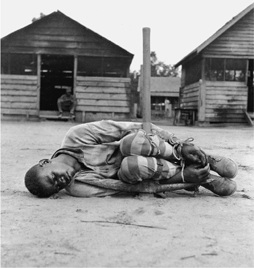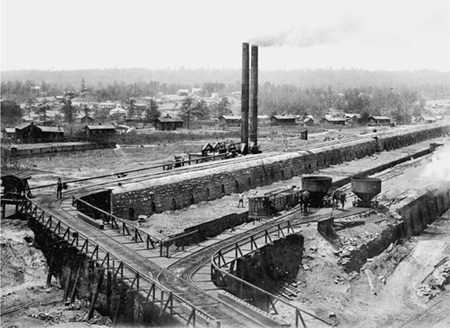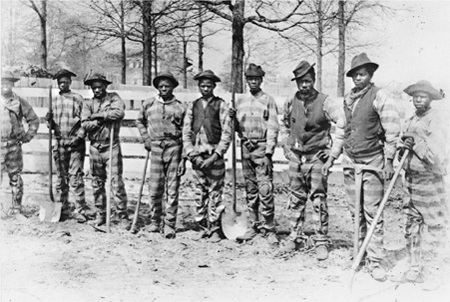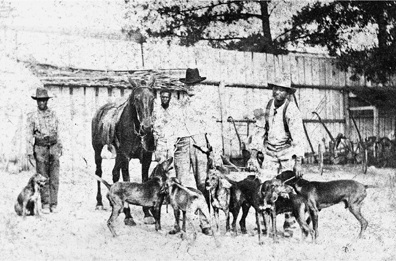Slavery by Another Name (36 page)
Read Slavery by Another Name Online
Authors: Douglas A. Blackmon

plain sight.
A lawyer named L. E. White, from Columbus, Georgia, a bustling
town on the main train line running through Tal apoosa County,
told Reese how he had traveled to Dadevil e the previous summer
looking for a missing young black man named Esau Wil iams. He
tracked him down at a farm owned by Fletch Turner, where
Wil iams and several other black men were being forced to cut
wood. White bought his freedom for $25 and returned the boy to
his mother.
A few weeks later, the family of Glennie "Speedy" Helms, another
young black man who had been traveling with Wil iams, sent the
lawyer back looking for their son. White found him and more than
a half dozen others working at a sawmil owned by Turner near the
set lement cal ed Jackson's Gap. He had to pay $48 for Helms. But
most striking to White were the execrable working conditions he
found—a scene that must have been strikingly similar to the
operations of the slavery-driven sawmil near the Cot ingham
plantation half a century earlier. "When I found this boy he was at
the sawmil at work completely naked, no clothes on at al ,
absolutely naked," White said. "And there were some six or eight
other negroes there working in the same naked condition."34
Reese was astonished by the evidence piling up in his o ce, and
quickly asked for the assignment of two Secret Service agents to
assist. "I never comprehended until now the extent of the present
method of slavery," he wrote to At orney General Knox,35 asking for
a meeting in Washington to plan a dramatic legal at ack.
The investigation could only have occurred with a man such as
Warren Reese in the role of U.S. at orney. Reese and two part-time
assistants constituted the sum total of the U.S. government's
regulatory and judicial reach into the portion of Alabama he served.
It would be another ve years before the agency that became the
Federal Bureau of Investigation was created in Washington. Until
then, the handful of investigators employed by the U.S. Justice
Department were nearly al accountants temporarily retained from
the examiners section of the Treasury Department. The reach of
the examiners section of the Treasury Department. The reach of
federal power in a place as remote as Alabama was only as strong
as the capabilities and political wil s of the local U.S. at orney and
federal judge.
The thirty-seven-year-old Reese exempli ed the new phenotype
of political and racial moderate that Roosevelt believed could
emerge as a new leadership class in the South—a counterpoint of
reason and modernism to noxious characters like John Pace and
other men who perverted judicial and political systems against
blacks and the constitutional amendments that were supposed to
have freed them.
Born just after the Civil War, Reese was a new husband and fast-
rising at orney in the state's capital city in 1903. Handsome, with an
academic air, Reese's piercing gaze at juries was softened by a long,
narrow face. An eloquent speaker and a orid writer, the at orney
was just mature enough to win credibility in the courtroom, just
youthful enough to ignore the obvious jeopardy that would mount
as he pressed an at ack on slavery and some of his state's most
powerful men. As al egations of slavery in his jurisdiction
multiplied, Reese demonstrated a prehensile comprehension of the
murky legal framework governing black labor, and a hard-nosed
unwil ingness to ignore the implications of the extraordinary
evidence that soon poured into his of ice.
Despite Reese's Republican a liation in rabidly Democratic and
white supremacist Alabama, he carried the social credentials of a
true son of the South. His father, W. S. Reese Sr., was a war hero
who at the age of nineteen earned a commission as a Confederate
colonel for gal antry during the ghting at Chickamauga Creek in
Georgia. After the war, the elder Reese became an activist in
Republican politics, successful y serving as mayor of Montgomery in
the 1880s and running unsuccessful y for the U.S. Senate in 1896 as
a Republican "fusion" candidate—at empting to at ract both black
and white voters. Reese's maternal grandfather, John A. Elmore,
was among Alabama's most famous at orneys—an architect of the
national government of the Confederacy and a key player in
secessionist politics at the dawn of the Civil War.
secessionist politics at the dawn of the Civil War.
Even Alabama's leading Democrats could muster no authentic
opposition to Reese's appointment to the federal post. Dozens of
endorsements poured into the White House and headquarters of the
Department of Justice in 1897, including each state Supreme Court
justice, local judges across Alabama, bankers, railroad executives,
the president of the state senate, the speaker of the Alabama house,
Governor Joseph F. Johnston, the secretary of state, U.S. senators,
and every Republican member of the Alabama legislature. White
Republicans in Alabama saw in Reese the pro le of a potential y
dynamic new base of support—a fresh antidote to the planter class
that dominated Democratic politics, but one who could avoid the
carpetbagger taint of the Reconstruction-era Grand Old Party. "He is
a young man of promise, belongs to an old and in uential family of
this state—the source from which we must have recruits if we
expect permanent and lasting growth for republicanism in the
South," wrote one Alabama GOP leader, in a let er endorsing
Reese's candidacy. He was sworn in as U.S. at orney by President
McKinley in April 1897.36
Four years later, Roosevelt's optimism that men such as the
Reeses and Judge Thomas Jones could change the course of
southern thinking failed to account for the most powerful social
currents surging through the region. Not incidental y, Colonel Reese
and Judge Jones knew each other at least partly through their
prominent roles in the years-long drive in the 1880s to erect a
massive monument to Confederate war dead and veterans in
Montgomery. Their participation underscored the treacherous
political and social straits through which white southern moderates
were forced to navigate at the turn of the century. In the rst four
decades after the war, southern nativity and service in the war, as
Reese and Jones each claimed, were enough to meet the
prerequisites for elected o ce and leadership—and enough to at
least partly inoculate them against the charge that any white man
who supported legal rights for freed slaves was a traitor to his
region.
As the twentieth century neared, though, the orthodoxy of
As the twentieth century neared, though, the orthodoxy of
southern patriotism was mutating virulently. It was no longer
enough to have served honorably. The South now demanded in
public forums an increasingly rabid level of absolute adherence to a
baroque new mythology of the honorable southerner, the contented
slave, and the tragical y defeated secession. The new monument in
Montgomery, one of the largest such memorials anywhere in the
South, was that mythology incarnate. The aging former rebel
president, Je erson Davis, personal y laid its cornerstone on the
grounds of the state capitol, just a short distance from the spot
where he had taken the oath of o ce as president of the
Confederacy. The completed edi ce consisted of four statues
representing the four branches of military service spaced around the
base of an enormous column rising seventy feet above a bronze bas-
relief of a bat le scene.
Atop the shaft of Alabama limestone stood a ten-foot bronze
statue of a soldier titled Patriotism. After two decades of planning
and fund-raising, the monument was nal y unveiled before tens of
thousands of spectators in 1898. Undoubtedly, young Warren Reese
Jr. was among them.
A series of orators extol ed the virtuousness of the southern
rebel ion and the bravery and tenacity of its soldiers. Flanking the
scene was a contingent of young maidens, dressed in pure white,
gray caps, and crimson sashes, each representing one of the
Confederate states. Below the sculpture entitled Cavalry, an
inscription honored the horsemen of the rebel ion as "the
knightliest of the knightly race."37 As special agents scoured the
backcountry of Alabama ve years later, and brought tales of horror
to Montgomery in the spring of 1903, the cynicism of the South's
claim to hold a special position among the most noble civilizations
could not have escaped Reese's acute powers of observation.

An unnamed prisoner tied around a pickax for punishment in a
Georgia labor camp. Photograph by John L. Spivak, during research
for his 1932 book, Georgia Nigger.

Tennessee Coal, Iron & Railroad coke ovens at the Prat Mines near
Birmingham, Alabama.


A southern chain gang in 1898. Photograph by Carl Weis.